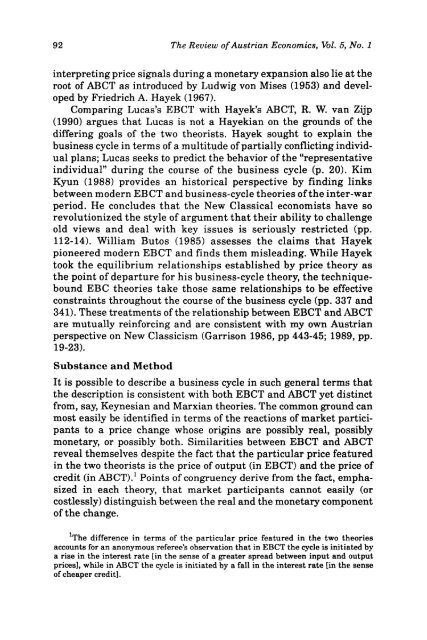Review of Austrian Economics - The Ludwig von Mises Institute
Review of Austrian Economics - The Ludwig von Mises Institute
Review of Austrian Economics - The Ludwig von Mises Institute
You also want an ePaper? Increase the reach of your titles
YUMPU automatically turns print PDFs into web optimized ePapers that Google loves.
92 <strong>The</strong> <strong>Review</strong> <strong>of</strong> <strong>Austrian</strong> <strong>Economics</strong>, Vol. 5, No. 1<br />
interpreting price signals during a monetary expansion also lie at the<br />
root <strong>of</strong> ABCT as introduced by <strong>Ludwig</strong> <strong>von</strong> <strong>Mises</strong> (1953) and developed<br />
by Friedrich A. Hayek (1967).<br />
Comparing Lucas's EBCT with Hayek's ABCT, R. W. van Zijp<br />
(1990) argues that Lucas is not a Hayekian on the grounds <strong>of</strong> the<br />
differing goals <strong>of</strong> the two theorists. Hayek sought to explain the<br />
business cycle in terms <strong>of</strong> a multitude <strong>of</strong> partially conflicting individual<br />
plans; Lucas seeks to predict the behavior <strong>of</strong> the "representative<br />
individual" during the course <strong>of</strong> the business cycle (p. 20). Kim<br />
Kyun (1988) provides an historical perspective by finding links<br />
between modern EBCT and business-cycle theories <strong>of</strong> the inter-war<br />
period. He concludes that the New Classical economists have so<br />
revolutionized the style <strong>of</strong> argument that their ability to challenge<br />
old views and deal with key issues is seriously restricted (pp.<br />
112-14). William Butos (1985) assesses the claims that Hayek<br />
pioneered modern EBCT and finds them misleading. While Hayek<br />
took the equilibrium relationships established by price theory as<br />
the point <strong>of</strong> departure for his business-cycle theory, the techniquebound<br />
EBC theories take those same relationships to be effective<br />
constraints throughout the course <strong>of</strong> the business cycle (pp. 337 and<br />
341). <strong>The</strong>se treatments <strong>of</strong> the relationship between EBCT and ABCT<br />
are mutually reinforcing and are consistent with my own <strong>Austrian</strong><br />
perspective on New Classicism (Garrison 1986, pp 443-45; 1989, pp.<br />
19-23).<br />
Substance and Method<br />
It is possible to describe a business cycle in such general terms that<br />
the description is consistent with both EBCT and ABCT yet distinct<br />
from, say, Keynesian and Marxian theories. <strong>The</strong> common ground can<br />
most easily be identified in terms <strong>of</strong> the reactions <strong>of</strong> market participants<br />
to a price change whose origins are possibly real, possibly<br />
monetary, or possibly both. Similarities between EBCT and ABCT<br />
reveal themselves despite the fact that the particular price featured<br />
in the two theorists is the price <strong>of</strong> output (in EBCT) and the price <strong>of</strong><br />
credit (in ABCT). 1 Points <strong>of</strong> congruency derive from the fact, emphasized<br />
in each theory, that market participants cannot easily (or<br />
costlessly) distinguish between the real and the monetary component<br />
<strong>of</strong> the change.<br />
lr <strong>The</strong> difference in terms <strong>of</strong> the particular price featured in the two theories<br />
accounts for an anonymous referee's observation that in EBCT the cycle is initiated by<br />
a rise in the interest rate [in the sense <strong>of</strong> a greater spread between input and output<br />
prices], while in ABCT the cycle is initiated by a fall in the interest rate [in the sense<br />
<strong>of</strong> cheaper credit].

















